The Swedish Migration Agency answers:
Who comes to Sweden – and why?
Around 190,000 people applied for a residence permit in Sweden last year, and 132,000 people were granted permission to be here. These included refugees, employees, students and close relatives of people who already live here, from all over the world. In this article, we will answer questions about who comes to Sweden, why, and how migration to Sweden developed between 2013 and 2022.*
Over the past decade, migration to Sweden has been characterised by dramatic changes. Over the course of just two years, 2014–2015, a quarter of a million asylum seekers came to Sweden, which led to temporary border controls and stricter migration legislation.
After that, the number of asylum seekers fell sharply. Sweden has gone from receiving around 10 percent of the EU’s asylum seekers in the years before 2016 to less than 1.5 percent so far this year.
An exception to the trend of fewer people seeking protection here occurred last year, following Russia’s full-scale invasion of Ukraine. Millions of Ukrainians then sought protection in Europe, the EU activated the Temporary Protection Directive, and about 50,000 people received protection in Sweden.
In parallel with major fluctuations in migration policy, the number of people who came here to work increased during the period 2013–2022. In 2023, about the same number of people have applied for protection in Sweden as for work permits.
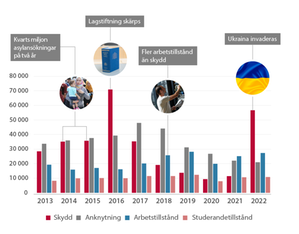 Zoom image
Zoom imageNumber of residence permits granted per category 2013–2022. The bars represent protection (red), family reunion (grey) work (blue), student (pink). The pictures (left-right: A quarter of a million asylum seekers to Sweden in two years, Restrictive legislation, More work permits than protection permits granted, Invasion of Ukraine. Press to enlarge.
Over the past decade, more than half a million people have sought protection here
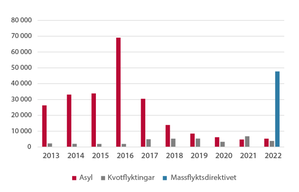 Zoom image
Zoom imageNumber of residence permits granted for protection per category 2013–2022. The bars represent asylum protection (red), UN quota refugee (grey), EU Temporary Protection directive (blue). Press to enlarge.
Between 2013 and 2022, more than half a million (550,630) first-time applications for protection were submitted in Sweden. This figure also includes quota refugees and people from Ukraine who have received protection under the Temporary Protection Directive. More than half the applicants (328,632) were granted protection in Sweden.
Here it should be pointed out that the Swedish Migration Agency only reports granted permits, not the length of a permit’s validity or whether the person who received the permit has remained in Sweden. This became particularly important in connection with the tightening of the law in 2016, when temporary residence permits became the norm, as opposed to the permanent ones that had typically been granted previously. But this also applies to other types of residence permits, for example permits to work or study here. Another aspect of the statistics in this article is that they only present figures for first-time applications, not extensions.
Many close relatives wanted to be reunited with their families
The large number of asylum seekers in the years up to and including 2015 led to a sharp increase in the number of family members applying for residence permits on the basis of family ties. During the period 2013–2022, nearly half a million people applied for a residence permit to move to Sweden to join someone already living here.
In addition to the families of persons seeking protection, the statistics on family ties also include other groups, such as close relatives of Swedish citizens who wish to obtain a residence permit in Sweden. This makes it difficult to provide figures on how many close relatives wanted to settle here with an asylum seeker, compared to those who wanted to live with Swedish citizens.
From protection to work permits and students
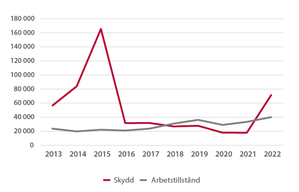 Zoom image
Zoom imageNumber of residence permits sought for protection and work 2013–2022. Press to enlarge. The lines represent protection (red) and work (grey).
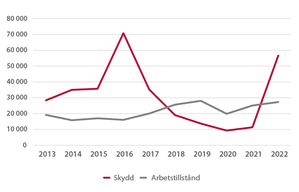 Zoom image
Zoom imageNumber of residence permits granted for protection and work 2013–2022. Press to enlarge. The lines represent protection (red) and work (grey).
Between 2013 and 2022, the composition of people who wanted to come to Sweden shifted from asylum seekers to employees and students. In somewhat simplified terms (and with the exception of the Temporary Protection Directive), in recent years about twice as many people have been granted work permits compared to asylum. In other words, more people are granted a work permit than are granted asylum.
From 2013 to 2022, more than 300,000 people were granted residence permits to work in Sweden. When it comes to employees, some come here for a seasonal job, while others come to Sweden to stay – and these statistics only show that they have been granted a residence permit. This also applies to students, who are even more involved in so-called "circular migration", which means that they usually leave the country once their studies are completed.
During the pandemic, all types of cases were affected by the travel restrictions, but especially those of employees and students. When it comes to employees, other factors and regulations affect the number and nationality of people who come to Sweden. These include the state of the economy, the attractiveness of other countries, and the availability of skills in Sweden and in other countries.
The number of students coming to Sweden has also increased, but at lower levels – from around 10,000 to just under 15,000 per year. One factor that has affected both employees and students is the requirement that applicants present their passport in person at an embassy or consulate-general.
What countries do people come from?
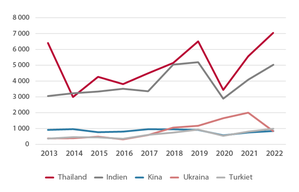 Zoom image
Zoom imageNumber of work permits granted per nationality 2013–2022. Press to enlarge.
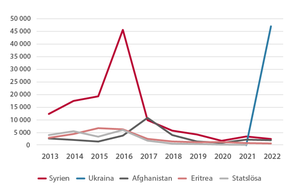 Zoom image
Zoom imageNumber of residence permits for protection granted per nationality 2013–2022. Press to enlarge
There are a number of reasons why people from various countries choose to come to Sweden. The situation in their country of origin, diaspora in Sweden, and Swedish legislation – these are just a few reasons why people of certain nationalities choose to come here. Of course, similar factors also affect the attractiveness of other recipient countries.
To get an indication of how this has developed during the period 2013–2022, the granted residence permits for protection (asylum, quota refugees, and the Temporary Protection Directive) are compared with granted work permits.
Of those who received protection in Sweden between 2013 and 2022, Syria was the predominant country of origin (with the exception of 2022, when Ukraine topped the list). Other major countries of origin during the period were Afghanistan, Eritrea, Iraq and Somalia.
During the same time span, Thailand, India, and China were the predominant countries of origin among those who came to Sweden to work. A great number of jobseekers have also arrived from Ukraine. A large proportion of Thais are seasonal workers, which means they come here for shorter periods than many other employees.
As has previously been mentioned in this article, two crucial trends during this period have been a decline in asylum seekers (with the exception of the war in Ukraine) and an increase in employees and students coming to Sweden. This has meant a shift in nationalities, from citizens of war-torn countries such as Syria and Afghanistan to those of developing economies like India and China. Last year, permits were granted to more employees from India than asylum seekers from Syria, Afghanistan and Eritrea combined (the largest refugee groups, after Ukraine, in 2022).
What’s next?
As has already been mentioned, Sweden’s share of persons seeking protection within the EU has decreased in recent years. Taking into account current legislation and the Government’s political reform agenda, the Swedish Migration Agency has assessed that this development will continue, despite unrest in the outside world. In areas other than asylum, policy is also leaning towards accepting fewer migrants into the country, rather than more. From October, there will be an increased maintenance requirement for labour migrants, as a result of which it is expected that fewer employees will come to Sweden.